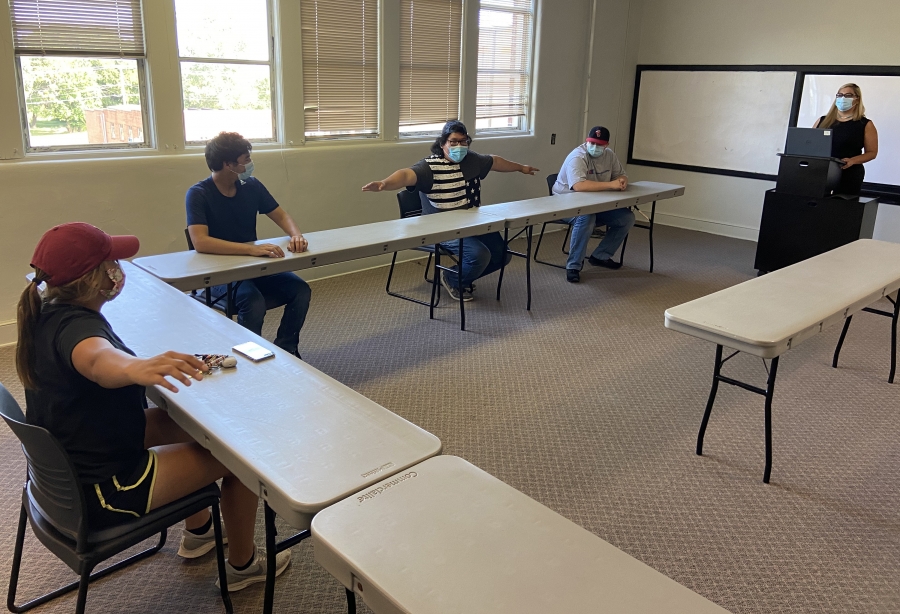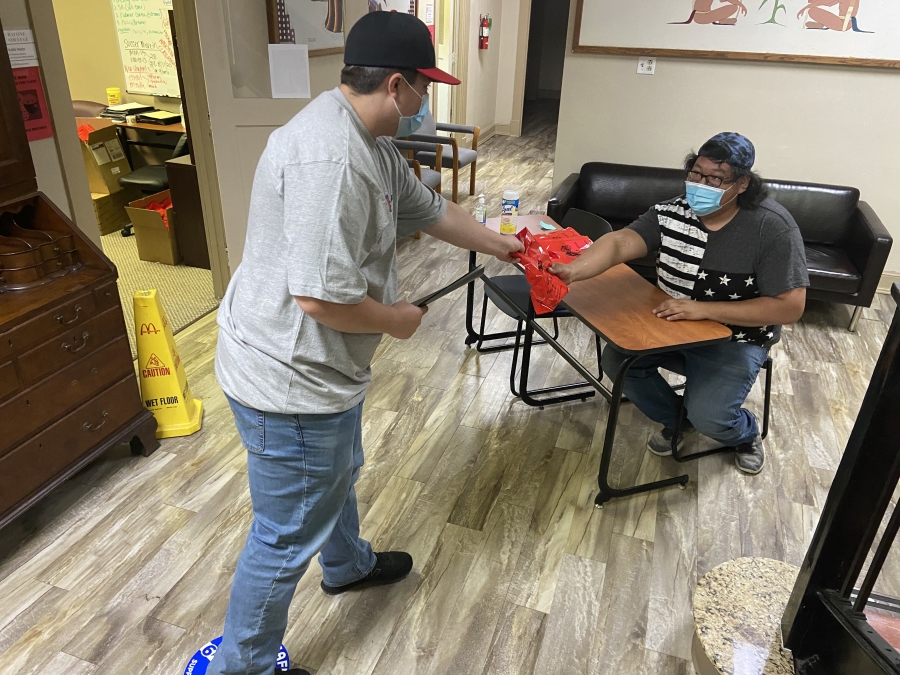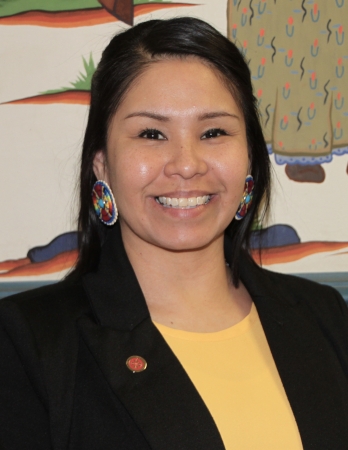
- Details
- By Chez Oxendine
MUSKOGEE, Okla. — In 2018, facing severe financial stress, Bacone College in Muskogee, Okla. nearly shuttered its doors. Now facing another significant challenge, the nation’s oldest Native American university says the COVID-19 pandemic hasn’t slowed its efforts to return to its Native roots.
“When I prepared my enrollment projections, I did that in a five-year span. With COVID-19, we took into consideration what other institutions took into consideration. Most institutions went on ahead and prepared for 20 percent reduction,” said Vice President of Student Affairs Kaila Harjo. “I said I'm only going to predict a 15 percent reduction.”
The school did even better — amid a wave of campus closures and changes across the country, Bacone’s fall enrollment stands at 264 students. That’s compared to 273 enrolled students in the fall semester of 2019.
“We have surpassed what we thought we were going to lose,” Harjo said. “We've also increased our residential numbers. We have taken every precaution that we can consider to keep our students safe.”
Bacone’s COVID-19 preparation began in late January and early February, Harjo said.
 Student Ty Maxwell Muscogee (Creek) receives a care kit with gloves, disposable mask, washable mask and sanitizer during housing check-in for athletes the week prior to school starting. Housing Director Kendall Scott (Kickapoo), right, set up the checkpoint as the students' last stop before getting keys to their dorms.
Student Ty Maxwell Muscogee (Creek) receives a care kit with gloves, disposable mask, washable mask and sanitizer during housing check-in for athletes the week prior to school starting. Housing Director Kendall Scott (Kickapoo), right, set up the checkpoint as the students' last stop before getting keys to their dorms.
“Our executive team got together and said what happens if [the virus] makes it here? We laid out a temporary plan so that we could have something in place. As soon as it hit Oklahoma, we knew that parents were going to be concerned with their students,” Harjo said. “We talked about things we might consider in our normal everyday life. We were sending emails to students: make sure you're keeping a safe distance, make sure you're washing your hands.”
As April approached and COVID-19 cases began to trend upward, Bacone sent its residential students home. They’re taking a different approach this fall, Harjo said.
“In the spring of 2020 we realized that sending students home because of COVID-19 may not have been the best choice for some of those students,” she said. “If it presents itself to us that we need to be all online, we will keep our dorms open. We recently made renovations to our dorms, so that way our students are more comfortable if they are encouraged or asked to remain inside for a number  Kaila Harjo, Vice President of Student Affairs at Bacone College.of days. We're still on a good path to bringing Bacone back to a respectful institution.”
Kaila Harjo, Vice President of Student Affairs at Bacone College.of days. We're still on a good path to bringing Bacone back to a respectful institution.”
Commencement was moved from early May to December, with plans in place to eventually reopen campus.
“We were tasked with, ‘When do you think we can reopen?’” Harjo said. “Our COVID-19 response team got together on Zoom. Then June 1 hits and the numbers start going up tremendously.”
That prompted multiple safety measures — including keeping test results on file, Harjo said.
“One of the most crucial pieces of our policy is that all of our residential students, our faculty and our staff, have to have a negative COVID-19 test on file to be on campus,” Harjo said.
The school has also expanded learning options for students who might feel uncomfortable going to class gatherings, even if they’re staying on campus, she noted.
“That's one thing we wanted to make sure that our students knew — if you don't feel comfortable coming to campus, or you're mistrusting of your surroundings, you have the option to take all of your classes at home,” Harjo said.
The changes come amid a slow shift in Bacone’s identity. Athletics programs have been pared back as the school works to rebuild its Native American roots.
“We did increase our Native American population from 29 percent to 69 percent,” Harjo said. “That has allowed us to slowly rebuild our relationship with the Native tribes of Oklahoma, as well as nationally.”
So far, the change in priorities has worked well for the school, Harjo added.
“One of the things we've focused on is our retention rate. For the fall of 2019 to spring 2020, we had a 90 percent retention rate. We're on a promising, motivating path to fulfilling education,” she said.
The key to maintaining those numbers amid a pandemic is to ensure the safety of everyone on campus, Harjo explained.
“As a mom, I want to know what the school's going to do to prepare my child. My mom mode always kicks in when it comes to these Bacone students,” she said. “Their moms are trusting us to keep their children safe while they're here and I like to think we do a good job of that.”
But it also means adapting to ever-changing circumstances.
“I wish I knew what was going to present itself as far as COVID-19 and how our campus makes adjustments,” Harjo said. “You've got to be creative. You've got to think outside the box. We're just taking it day by day, reevaluating the resources we have and making sure that our students remain safe.”
More Stories Like This
American Indian College Fund Names 12 Student Ambassadors for 2025–262025 State of the American Indian College Fund Released for Native American Heritage Month
American Indian College Fund Launches National Campaign for Native American Heritage Month
Four-Day Event Will Connect TCUs with Native Students Interested in Pursuing Higher Education
Native Women Share Their Journeys in Higher Education in New Book
Help us tell the stories that could save Native languages and food traditions
At a critical moment for Indian Country, Native News Online is embarking on our most ambitious reporting project yet: "Cultivating Culture," a three-year investigation into two forces shaping Native community survival—food sovereignty and language revitalization.
The devastating impact of COVID-19 accelerated the loss of Native elders and with them, irreplaceable cultural knowledge. Yet across tribal communities, innovative leaders are fighting back, reclaiming traditional food systems and breathing new life into Native languages. These aren't just cultural preservation efforts—they're powerful pathways to community health, healing, and resilience.
Our dedicated reporting team will spend three years documenting these stories through on-the-ground reporting in 18 tribal communities, producing over 200 in-depth stories, 18 podcast episodes, and multimedia content that amplifies Indigenous voices. We'll show policymakers, funders, and allies how cultural restoration directly impacts physical and mental wellness while celebrating successful models of sovereignty and self-determination.
This isn't corporate media parachuting into Indian Country for a quick story. This is sustained, relationship-based journalism by Native reporters who understand these communities. It's "Warrior Journalism"—fearless reporting that serves the 5.5 million readers who depend on us for news that mainstream media often ignores.
We need your help right now. While we've secured partial funding, we're still $450,000 short of our three-year budget. Our immediate goal is $25,000 this month to keep this critical work moving forward—funding reporter salaries, travel to remote communities, photography, and the deep reporting these stories deserve.
Every dollar directly supports Indigenous journalists telling Indigenous stories. Whether it's $5 or $50, your contribution ensures these vital narratives of resilience, innovation, and hope don't disappear into silence.
 The stakes couldn't be higher. Native languages are being lost at an alarming rate. Food insecurity plagues many tribal communities. But solutions are emerging, and these stories need to be told.
The stakes couldn't be higher. Native languages are being lost at an alarming rate. Food insecurity plagues many tribal communities. But solutions are emerging, and these stories need to be told.
Support independent Native journalism. Fund the stories that matter.
Levi Rickert (Potawatomi), Editor & Publisher

